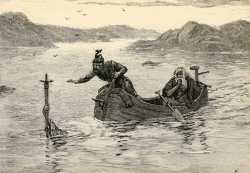Excalibur
by Brian Edward Rise
The magical sword of Arthur in the romances. Its name is derived from Geoffrey of Monmouth's "Caliburn" which itself mimics the Latin chalybs, or "steel." Sometimes identified as the Sword in the Stone, usually it is not. One account states that it belonged to Gawain first. The most familiar version has Arthur break the sword drawn from the stone and Merlin arranges its replacement with a weapon of supernatural power. Together they meet the Lady of the Lake whose hand, clad in shimmering samite, holds aloft Excalibur from the water. Merlin instructs Arthur that the scabbard is actually of more value for he cannot lose blood so long as he carries it. It is Morgan's plotting that leads to the scabbard's disappearance.
After the final battle, as the King lies wounded, he orders one of the surviving knights, Bedivere or Griflet, to cast Excalibur into the water. The knight twice disobeys yet on the third trip throws the sword into the water where a hand rises, catches it and withdraws beneath the surface. Five places claim to be the location of this event including Dozmary Pool on Bodwin Moor and Pomparles Bridge near Glastonbury. Loe Pool in south Cornwall is Tennyson's location. Archeology has provided evidence of a custom that this tale echoes. In ancient times a warrior's sword was considered singular to him, imbued with his spirit. Sometimes his sword would be sunk into some body of water to discourage its retrieval by an enemy or anyone else.
When the Lionheart, Richard I, presented Tancred of Sicily with a sword on a visit in 1191, he claimed the sword was Arthur's. The King was doubtless aware of the discovery of the grave in Glastonbury since his father, Henry II, had used this story to silence Welsh rumors that the real Arthur would return. There is no clear idea where it came from. The incident would not have been at odds with any known tale since it had not yet been written in any extant text.
❧
